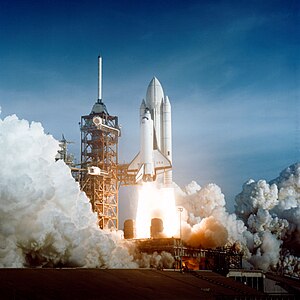This article needs additional citations for verification. (March 2017) |

A solid-propellant rocket or solid rocket is a rocket with a rocket engine that uses solid propellants (fuel/oxidizer). The earliest rockets were solid-fuel rockets powered by gunpowder. The inception of gunpowder rockets in warfare can be credited to the ancient Chinese, and in the 13th century, the Mongols played a pivotal role in facilitating their westward adoption.[1]
All rockets used some form of solid or powdered propellant until the 20th century, when liquid-propellant rockets offered more efficient and controllable alternatives. Because of their simplicity and reliability, solid rockets are still used today in military armaments worldwide, model rockets, solid rocket boosters and on larger applications.
Since solid-fuel rockets can remain in storage for an extended period without much propellant degradation, and since they almost always launch reliably, they have been frequently used in military applications such as missiles. The lower performance of solid propellants (as compared to liquids) does not favor their use as primary propulsion in modern medium-to-large launch vehicles customarily used for commercial satellites and major space probes. Solids are, however, frequently used as strap-on boosters to increase payload capacity or as spin-stabilized add-on upper stages when higher-than-normal velocities are required. Solid rockets are used as light launch vehicles for low Earth orbit (LEO) payloads under 2 tons or escape payloads up to 500 kilograms (1,100 lb).[2][3]
- ^ chapters 1–2, Blazing the trail: the early history of spacecraft and rocketry, Mike Gruntman, AIAA, 2004, ISBN 1-56347-705-X.
- ^ Culler, Jessica (2015-06-16). "LADEE - Lunar Atmosphere Dust and Environment Explorer". NASA. Retrieved 2020-06-02.
- ^ "LockMart And ATK Athena Launch Vehicles Selected As A NASA Launch Services Provider". www.space-travel.com.